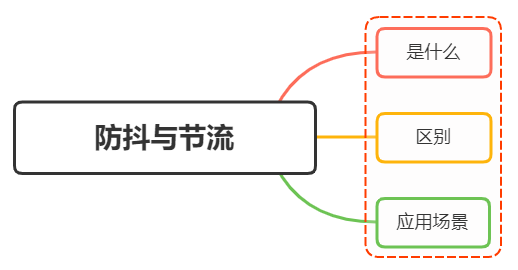面试官:什么是防抖和节流?有什么区别?如何实现?

一、是什么
本质上是优化高频率执行代码的一种手段
如:浏览器的 resize、scroll、keypress、mousemove 等事件在触发时,会不断地调用绑定在事件上的回调函数,极大地浪费资源,降低前端性能
为了优化体验,需要对这类事件进行调用次数的限制,对此我们就可以采用 防抖(debounce) 和 节流(throttle) 的方式来减少调用频率
定义
- 节流: n 秒内只运行一次,若在 n 秒内重复触发,只有一次生效
- 防抖: n 秒后在执行该事件,若在 n 秒内被重复触发,则重新计时
一个经典的比喻:
想象每天上班大厦底下的电梯。把电梯完成一次运送,类比为一次函数的执行和响应
假设电梯有两种运行策略 debounce 和 throttle,超时设定为15秒,不考虑容量限制
电梯第一个人进来后,15秒后准时运送一次,这是节流
电梯第一个人进来后,等待15秒。如果过程中又有人进来,15秒等待重新计时,直到15秒后开始运送,这是防抖
代码实现
节流
完成节流可以使用时间戳与定时器的写法
使用时间戳写法,事件会立即执行,停止触发后没有办法再次执行
js
function throttled1(fn, delay = 500) {
let oldtime = Date.now()
return function (...args) {
let newtime = Date.now()
if (newtime - oldtime >= delay) {
fn.apply(null, args)
oldtime = Date.now()
}
}
}function throttled1(fn, delay = 500) {
let oldtime = Date.now()
return function (...args) {
let newtime = Date.now()
if (newtime - oldtime >= delay) {
fn.apply(null, args)
oldtime = Date.now()
}
}
}使用定时器写法,delay毫秒后第一次执行,第二次事件停止触发后依然会再一次执行
js
function throttled2(fn, delay = 500) {
let timer = null
return function (...args) {
if (!timer) {
timer = setTimeout(() => {
fn.apply(this, args)
timer = null
}, delay);
}
}
}function throttled2(fn, delay = 500) {
let timer = null
return function (...args) {
if (!timer) {
timer = setTimeout(() => {
fn.apply(this, args)
timer = null
}, delay);
}
}
}可以将时间戳写法的特性与定时器写法的特性相结合,实现一个更加精确的节流。实现如下
js
function throttled(fn, delay) {
let timer = null
let starttime = Date.now()
return function () {
let curTime = Date.now() // 当前时间
let remaining = delay - (curTime - starttime) // 从上一次到现在,还剩下多少多余时间
let context = this
let args = arguments
clearTimeout(timer)
if (remaining <= 0) {
fn.apply(context, args)
starttime = Date.now()
} else {
timer = setTimeout(fn, remaining);
}
}
}function throttled(fn, delay) {
let timer = null
let starttime = Date.now()
return function () {
let curTime = Date.now() // 当前时间
let remaining = delay - (curTime - starttime) // 从上一次到现在,还剩下多少多余时间
let context = this
let args = arguments
clearTimeout(timer)
if (remaining <= 0) {
fn.apply(context, args)
starttime = Date.now()
} else {
timer = setTimeout(fn, remaining);
}
}
}防抖
简单版本的实现
js
function debounce(func, wait) {
let timeout;
return function () {
let context = this; // 保存this指向
let args = arguments; // 拿到event对象
clearTimeout(timeout)
timeout = setTimeout(function(){
func.apply(context, args)
}, wait);
}
}function debounce(func, wait) {
let timeout;
return function () {
let context = this; // 保存this指向
let args = arguments; // 拿到event对象
clearTimeout(timeout)
timeout = setTimeout(function(){
func.apply(context, args)
}, wait);
}
}防抖如果需要立即执行,可加入第三个参数用于判断,实现如下:
js
function debounce(func, wait, immediate) {
let timeout;
return function () {
let context = this;
let args = arguments;
if (timeout) clearTimeout(timeout); // timeout 不为null
if (immediate) {
let callNow = !timeout; // 第一次会立即执行,以后只有事件执行后才会再次触发
timeout = setTimeout(function () {
timeout = null;
}, wait)
if (callNow) {
func.apply(context, args)
}
}
else {
timeout = setTimeout(function () {
func.apply(context, args)
}, wait);
}
}
}function debounce(func, wait, immediate) {
let timeout;
return function () {
let context = this;
let args = arguments;
if (timeout) clearTimeout(timeout); // timeout 不为null
if (immediate) {
let callNow = !timeout; // 第一次会立即执行,以后只有事件执行后才会再次触发
timeout = setTimeout(function () {
timeout = null;
}, wait)
if (callNow) {
func.apply(context, args)
}
}
else {
timeout = setTimeout(function () {
func.apply(context, args)
}, wait);
}
}
}二、区别
相同点:
- 都可以通过使用
setTimeout实现 - 目的都是,降低回调执行频率。节省计算资源
不同点:
- 函数防抖,在一段连续操作结束后,处理回调,利用
clearTimeout和setTimeout实现。函数节流,在一段连续操作中,每一段时间只执行一次,频率较高的事件中使用来提高性能 - 函数防抖关注一定时间连续触发的事件,只在最后执行一次,而函数节流一段时间内只执行一次
例如,都设置时间频率为500ms,在2秒时间内,频繁触发函数,节流,每隔 500ms 就执行一次。防抖,则不管调动多少次方法,在2s后,只会执行一次
如下图所示:

三、应用场景
防抖在连续的事件,只需触发一次回调的场景有:
- 搜索框搜索输入。只需用户最后一次输入完,再发送请求
- 手机号、邮箱验证输入检测
- 窗口大小
resize。只需窗口调整完成后,计算窗口大小。防止重复渲染。
节流在间隔一段时间执行一次回调的场景有:
- 滚动加载,加载更多或滚到底部监听
- 搜索框,搜索联想功能